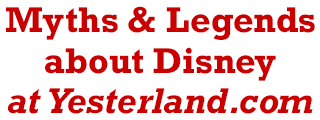
|
EPCOT Under Glass? | ||
|
|
|||
|
Some myths are propagated by a few talkative Walt Disney World bus drivers. Other myths are spread on the Internet as seemingly logical explanations for why odd things are the way they are. But here’s a myth that’s been spread by the New York Times, the Chicago Tribune, and other newspapers for almost 50 years.
|
|||
|
The Claim: EPCOT—the Experimental Prototype Community of Tomorrow, envisioned by Walt Disney before his death in 1966—was supposed to be enclosed by an immense dome. Status: False |
|||
|
|
|||
|
Before we get to the dome, let’s start with a quick, level-setting history lesson about EPCOT, the city, not Epcot, the theme park. In November 1965, Walt Disney announced that his company had acquired 27,443 acres in Central Florida. (In comparison, Disneyland began with just 200 acres.) Walt Disney was going into the city-building business. There were no details yet. |
|||

Scan from The Story of Walt Disney World, 1973 EPCOT, the city that was never built |
|||
|
The details finally came 15 months later. On February 2, 1967, journalists, business leaders, and government officials filled the Park West movie theater in Winter Park, a town north of Orlando. It was no accident that Walt Disney Productions chose a movie theater for the announcement. The presentation would feature Walt Disney’s final movie, filmed on October 27, 1966, just six days before Walt was diagnosed with cancer. On November 7, doctors removed his cancerous left lung. On December 15, 1966, the world lost a true creative genius. |
|||
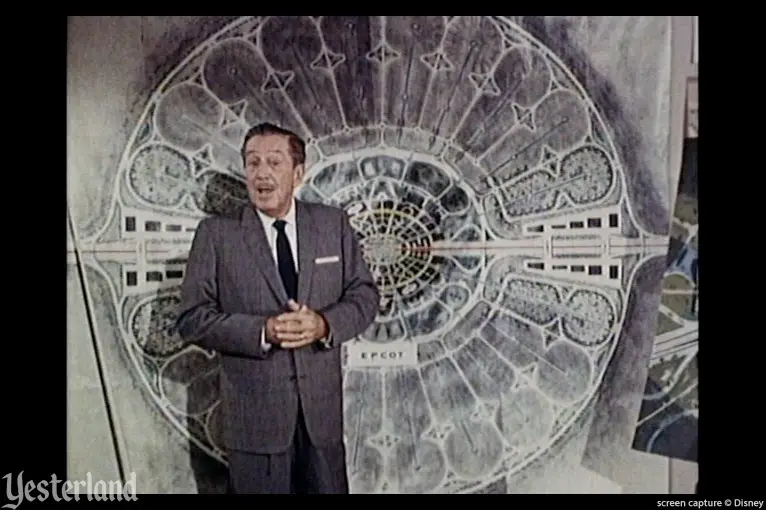
Screen capture from Walt Disney’s EPCOT film, 1966 Walt Disney with a plan showing the radial design of EPCOT |
|||
|
Despite already being in declining health, but not yet knowing why, Walt gave a brilliant performance. He shared his ideas and enthusiasm. After quickly mentioning that there would be “another amusement theme park in Florida similar to the one we have in California,” Walt devoted most of his portion of the 25-minute film to the centerpiece of the project: The most exciting, by far the most important part of our Florida project—in fact, the heart of everything we’ll be doing in Disney World—will be our experimental prototype city of tomorrow. We call it EPCOT, spelled E P C O T—Experimental Prototype Community of Tomorrow. Most of the second half of the film showed EPCOT concepts through limited animation, with a narrator explaining what the visuals meant. |
|||
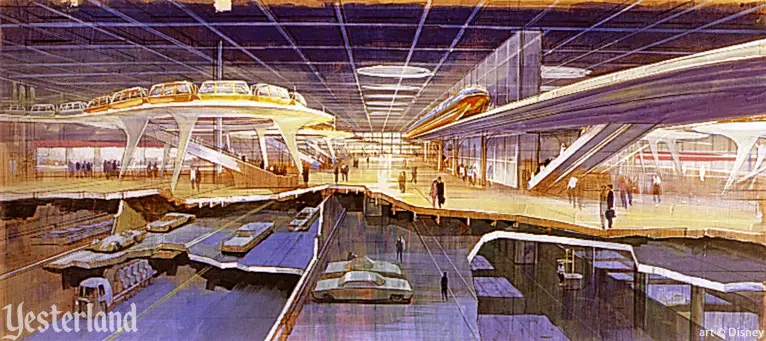
Walt Disney Productions publicity artwork, 1967 Concept art of EPCOT’s covered Transportation Lobby and the traffic layers below it. |
|||
|
The next morning, national and Florida newspapers published stories about Walt Disney Productions’ wondrous plans for Florida. Here are some excerpts: Walt Disney Productions today announced it would build the world’s first glass-domed city in central Florida amid Disneyworld, a $100-million entertainment center. — New York Times Plans for the world’s first glass domed city, a Disney World five times bigger than the Disneyland in California, were unveiled here yesterday. — Chicago Tribune Plans for a $600 million Disney World, complete with a bubble-top City of Tomorrow, were unwrapped here yesterday. The planned development includes an Experimental Prototype Community of Tomorrow (EPCOT) planned for 20,000 permanent residents. The city would be completely enclosed with a dome covering 50 to 75 acres and completely air conditioned. — St. Petersburg Times The world’s first glass-enclosed city—where more than 20,000 people will be able to forget about umbrellas—is included in the $600 million dream of the late Walt Disney for Central Florida. Disney Productions announced yesterday that a city under a glass dome will be the centerpiece of Disney World. — Ocala Star-Banner There was only one problem. In the film, neither Walt Disney nor the narrator said anything about putting the city under a giant bubble. None of the artwork showed a dome covering 50 to 75 acres. The detailed press release had nothing about a dome either. |
|||
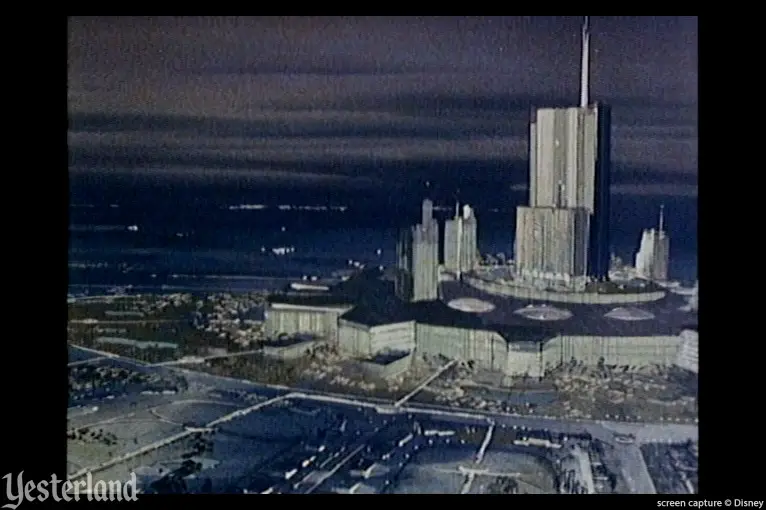
Screen capture from Walt Disney’s EPCOT film, 1966 EPCOT’s “dynamic urban center” |
|||
|
However, the film could give the impression that a dome was planned. About 15 minutes into the film, the film’s narrator began to discuss EPCOT’s “dynamic urban center.” There would be office buildings, restaurants, nightlife, and even “shopping areas where stores and whole streets recreate the character and adventure of places around the world.” |
|||
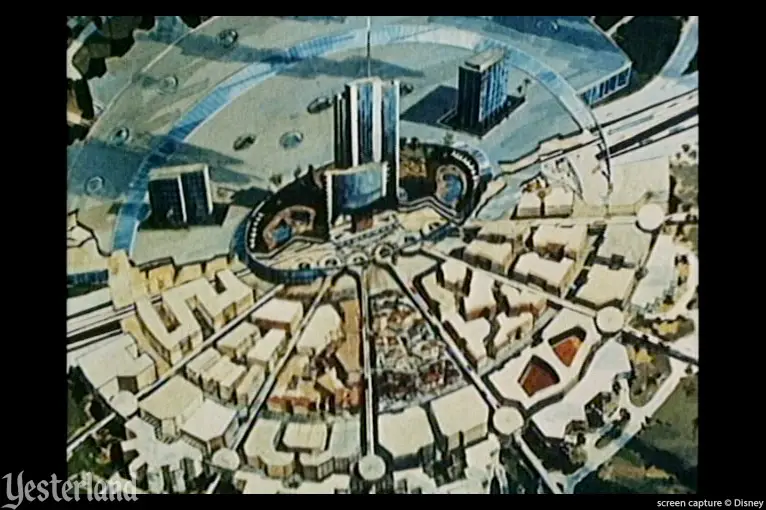
Screen capture from Walt Disney’s EPCOT film, 1966 |
|||
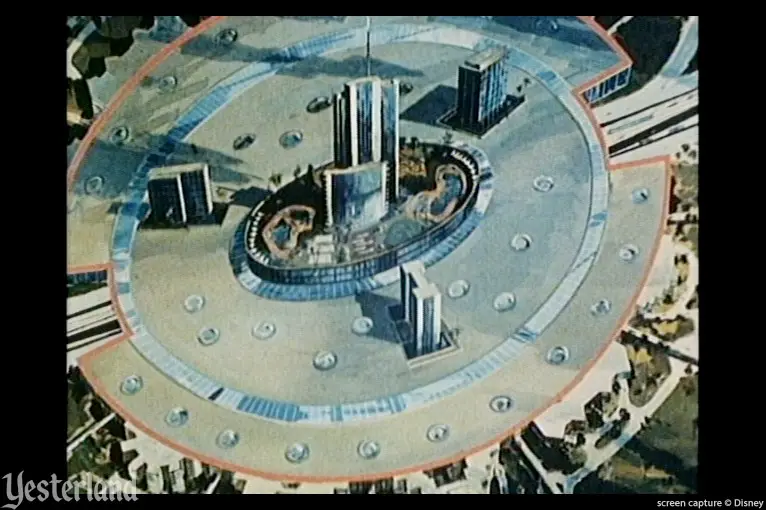
Screen capture from Walt Disney’s EPCOT film, 1966 Concept art for EPCOT city streets and buildings without the roof (top) and with the roof (bottom) |
|||
|
As the narrator spoke about office buildings, artwork showed central Epcot’s streets and buildings (top still). “But most important,” the narrator intoned, “this entire 50 acres of city streets and buildings will be completely enclosed,” as the partial roof on the artwork became a full roof (bottom still). Anyone in the audience who didn’t pay close attention could have missed the roof entirely, especially considering what came next... |
|||
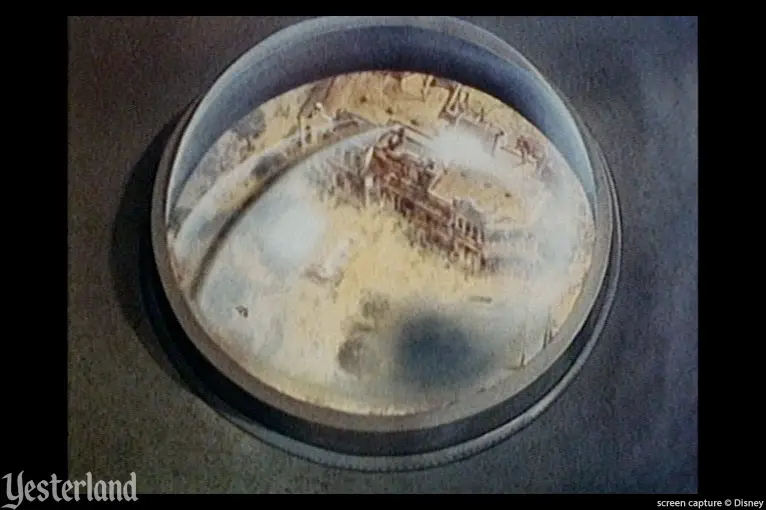
Screen capture from Walt Disney’s EPCOT film, 1966 The dome! |
|||
|
A quick transition revealed a clear, bubble-shaped dome over the city—or so it appeared—as the narrator continued, “In this climate-controlled environment, shoppers, theatergoers, and people just out for a stroll will enjoy ideal weather conditions, protected day and night from rain, heat and cold, and humidity.” But it wasn’t a 50-acre dome. It was one of the big, bubble-shaped skylights in the conventional roof. There was just a single block of themed buildings and streets below the dome, not an entire central city. That’s obvious if you look at the still or you replay the DVD several times. But it was not so obvious to the invited media watching the film only once in a theater. Yes, the plan was for EPCOT’s 50-acre core to be enclosed—just like the indoor shopping malls that were popping up in suburbs all over the United States at the time, only on a much larger scale. A huge dome would not have seemed that strange in the 1960s. The then-new Houston Astrodome stood 18 stories tall and covered almost 10 acres. New York World’s Fair (1964-1965) president Robert Moses had vetoed a temporary dome approximately a mile in diameter covering much of the 646-acre fairgrounds. And in 1960, engineer Buckminster Fuller and architect Shoji Sadao had proposed a two-mile diameter dome across Midtown Manhattan, covering more than 2,000 acres. Disney historian Jim Korkis noted, “By the time the film was shown, the idea of domed cities was fairly common in science fiction literature and films, which is why big news reporters leapt to that conclusion of this look of the future.” Millions of readers learned about the dome through newspaper stories written by journalists who understood “enclosed” to mean a giant transparent dome—news that was plausible yet still so amazing that the dome was in their article’s opening paragraphs. Ever since February 1967, newspaper stories that have mentioned the orignal EPCOT in any context often include the dome. Presumably, the writers did their research diligently, harvesting facts from articles of the past. For example, on September 30, 2012, the Staten Island Advance published “Disney’s EPCOT at 30: An unfulfilled dream might have changed New York City,” which included this paragraph: Perhaps the most intriguing aspect of the EPCOT plans was the fact that the center of the modern city was to have been completely enclosed under a dome—people would live, work and play in a climate-controlled environment, protected 24/7 from rain, heat, cold and humidity. Aside from the 21st century jargon “24/7,” the paragraph above could have been written 45 years ago. |
|||
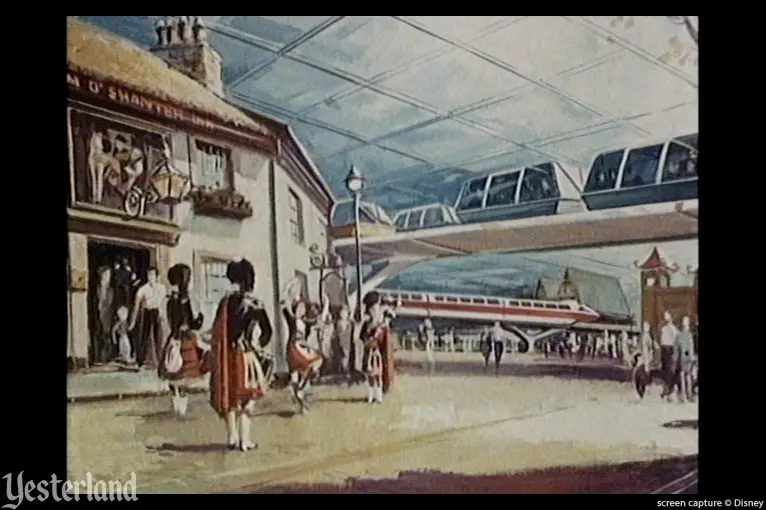
Screen capture from Walt Disney’s EPCOT film, 1966 An enclosed space at EPCOT—under a flat roof, not under a glass or plastic bubble |
|||
|
Speaking of 45 years ago, the perfect way to end this article would be with a firsthand explanation from someone who was personally involved with Disney park publicity back then. Disney Legend Charles Ridgway—whose 30-year Disney career included the position of Director of Press and Publicity for Walt Disney World since before it opened—was interviewed by Lou Mongello on Lou’s WDW Radio Show (WDWRadio.com) podcast (number 294), dated September 30, 2012. Here’s what Ridgway said: There were a lot of misconceptions about what Walt talked about, partly because the newspapers at the time wrote stories about it, and they interpreted his words to mean something that maybe he didn’t mean. The New York Times talked about a big plastic bubble that would control weather. Well, Walt talked about controlling weather, but he had nothing about plastic bubbles. |
|||
|
|
|||
| Click here to discuss this page at MiceChat! | |||
|
|
|||
|
|
© 2012-2015 Werner Weiss — Disclaimers, Copyright, and Trademarks Updated January 16, 2015 |
||